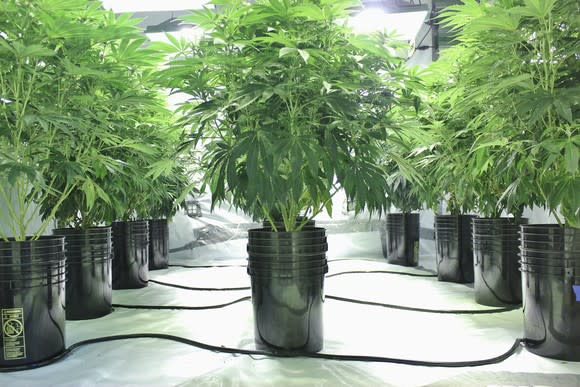Surprise! Ancillary Marijuana Stocks Aren't as Safe as They Appear
The marijuana industry is budding before our eyes in 2018, with history seemingly made every few weeks. Beginning in January, with Vermont's legalization of recreational weed entirely through the legislative process, all the way through Canada's legalization of adult-use marijuana in mid-October and Utah and Missouri giving the green light to medical cannabis in the U.S. last week, it's been a landmark year.
For investors, this can only mean one thing: big dollar signs. The global cannabis market could be worth as much as $75 billion by the time 2030 rolls around, according to an estimate from Cowen Group. Should these figures prove even remotely accurate, it would be an incredible opportunity for long-term investors to get in near the ground floor of a fast-growing industry.

Image source: Getty Images.
Ancillary pot stocks are generally considered "safe"...
But as investors, we also know that rarely do brand-new industries take off without a hitch. There has been no shortage of problems for direct players in the early going. For instance, despite regulators proclaiming that there would be no product shortages in Canada, numerous provinces had dispensaries close their doors just days -- or even hours -- after legalization became official. These shortages could substantially bring down sales projections for pot stocks in the near term.
Generally speaking, ancillary marijuana stocks are perceived to be the smartest and safest way to invest in the industry. By "ancillary," I mean the companies that provide the behind-the-scenes support for the cannabis industry, or businesses that are only reliant on the pot industry for a small percentage of total sales. Essentially, it's any company that doesn't come into direct contact with the cannabis plant.
However, marijuana investors were given a rude awakening this past week. Namely, they learned that ancillary stocks may not be as safe as first perceived following the fourth-quarter and full-year operating results from Scotts Miracle-Gro (NYSE: SMG).

Image source: Getty Images.
... but ancillary pot stocks carry risks as well
As you may or may not know, Scotts is typically lumped in as a "marijuana stock," but it hasn't historically relied on a significant percentage of sales from cannabis. First and foremost, it's a lawn and garden company, with its lawn-care segment providing $2.11 billion of the $2.66 billion in companywide sales in fiscal 2018. Although weather patterns can certainly impact Scotts Miracle-Gro's core operations, it's been a consistently profitable segment for a long time.
Then there's Scotts' Hawthorne Gardening Co. subsidiary, which is what caters primarily to the medical cannabis industry. Hawthorne provides hydroponic solutions -- that is, growing cannabis plants in a nutrient-rich water solvent -- as well as lighting, soil, and nutrient products to growers. Inclusive of its acquisition of Sunlight Supply, Hawthorne's sales grew by 20% in 2018 to $344.9 million, with an asterisk.
However -- and this is one heck of an asterisk -- Hawthorne's sales on an organic basis, without factoring in the company's acquisition, would have fallen 27% during fiscal 2018. This decline is due to weakness in the California weed market, where oversupply and dispensary licensing delays have hurt demand for hydroponics equipment. Though these supply issues should eventually work their way out, it led to a pretty ugly fourth quarter for Scotts Miracle-Gro. When the dust settled, Scotts recorded a nearly $131 million GAAP loss, $94.6 million of which was a goodwill impairment tied to its Hawthorne segment.
In other words, ancillary stocks are at risk from general cannabis weakness, even if their business models are only partially reliant on marijuana sales as a whole.

Image source: Getty Images.
The risk-versus-reward ratio is still favorable
Nevertheless, even with Scotts putting up a stinker of a quarter, ancillary pot stocks are still worth a look for investors who want exposure to the fast-paced growth of the legal weed industry without the exceptionally high volatility and uncertainty associated with direct players. Investors will just have to remember that the weed industry needs time to mature, and that could mean uncertain operating results, even for ancillary stocks, in the near term.
For instance, even if Scotts paid a premium to purchase Sunlight Supply, Hawthorne now possesses a broader scope of products that should appeal to a greater number of small and medium-sized cannabis growers. Not to mention, combining these two complementary businesses should yield $35 million in cost-saving synergies. That'll result in a solid boost in operating margins by next year.
The company also has its core lawn and garden segment, which has traditionally used innovation to drive results, and has had little trouble passing along price increases to consumers throughout the years. While not a fast-growing segment like Hawthorne, lawn and garden can often be counted on to provide steady single-digit sales growth.
Clearly, it's going to take time for ancillary pot stocks to pay off for investors. But if they're patient and willing to withstand some expected growing pains, the rewards could be well worth it.
More From The Motley Fool
Sean Williams has no position in any of the stocks mentioned. The Motley Fool has no position in any of the stocks mentioned. The Motley Fool has a disclosure policy.
